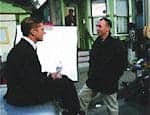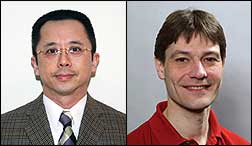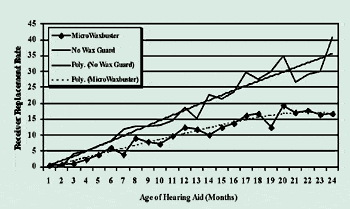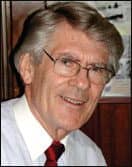Director/producer Eli Steele has overcome many of the challenges of a lifelong hearing impairment to face another challenge—a career in filmmaking.

Born with profound hearing loss, Eli Steele has not allowed that to stop him from pursuing his dream of being a film director and producer. Steele is currently completing his first feature film, What’s Bugging Seth, a project that the writer/director has been working on for 3 years. The movie follows the trials of a hearing impaired man, Seth, as he attempts to establish a bug extermination business, and find true love—either with model Nora or with double-amputee Alma. Steele hopes to have What’s Bugging Seth, which went into production in June, finished in time for January 2005’s Sundance Film Festival. Steele, who received a cochlear implant in 2000, recently spoke to Hearing Products Report (HPR) about his ambition to pursue a film career and the role he hopes What’s Bugging Seth will have in changing the public’s perception of the disabled.
HPR: How severe is your hearing loss?
Eli Steele: I was born with a bilateral profound hearing loss. I was diagnosed at the age of 1 and fitted with hearing aids. The next 4 years I went to oral programs and was eventually mainstreamed into first grade at my neighborhood school.
HPR: Did you wear hearing aids before your cochlear implant surgery? If so, what kind? Did they help you?
Steele: I wore primarily Phonak hearing aids until I was 26. They helped me immensely. My cochlear implant provides me with 10 times the sound that my hearing aids did, but I cannot deny the important role that they played [when I was growing up]. If I hadn’t had the hearing aids in my youth, I would not have been able to benefit as much as I did from my cochlear implant.
HPR: How did audiologists and other hearing health care professionals help you come to your decision about getting a cochlear implant?
Steele: My audiologist, Dr Janet Lang, was an enormous influence upon my hearing development. She was there from the very beginning. She had discussed the cochlear implant with my parents in the early 1980s but felt that I should not do it since I was doing well with the hearing aids and that the implant technology had not “matured” yet. However, she brought it up again in 1998 and mentioned the advances the implant had made. Since she wasn’t an official cochlear implant (CI) audiologist, I went to the House Ear Institute in Los Angeles. Dawna Mills became my CI audiologist and she was immensely helpful to me. The first time we met she spent 5 hours answering my questions and making sure that I had realistic expectations. What impressed me most about Dawna was her empathy. She can’t hear what I hear, but she has a very good instinct for mapping me in a way that allows me to benefit the most.
HPR: When and why did you decide to get a cochlear implant?
Steele: I decided to get a CI in 2000. I met a young lady, Erika Nelson, at a picnic. Upon discovering that she no longer had hearing aids but a CI, I quizzed her about everything. Can you go to movies? Can you talk on the phone? And so on. Since she shared a very similar hearing loss, I felt that, if she could do it, so could I.
HPR: When did you decide to pursue a film career? How did your deafness help and hinder your ambition?
Steele: I’ve wanted to be a filmmaker since I was 12. I always loved photography and writing, but I never thought about movies because I couldn’t enjoy them in the theater. That is until I went to see my very first foreign film, My Life as a Dog. It was the first time I really understood the magic of seeing and understanding a film on the big screen as opposed to TV. After that experience, I arrived at the conclusion that filmmaking was the perfect combo of writing and photography. My deafness never hindered me. I just never allowed it to. I know it may sound simplistic but that kind of outlook allows me to overcome any obstacle in front of me. When I first started writing scripts, my dialogue was terrible. Instead of blaming it on the fact that I can’t hear or listen in on other conversations, I treated it as a flaw in my writing ability and trained myself to write better dialogue.
HPR: Where did the idea for What’s Bugging Seth come from? How autobiographical is the movie?
Steele: What’s Bugging Seth is not autobiographical, but it is a world I know very well. I decided to make the movie when the idea of making Seth’s love interest a double amputee came to me. Because it meant that the movie was about how disabled people fit into the larger world. It wouldn’t just be about deafness—which plays a large role—but about disabilities in general. I thought this would touch upon the larger issues that affect all the disabled in general terms.
HPR: Did your own deafness and your experiences influence your decision to have your main character be hard of hearing?
Steele: Yes, my deafness definitely affected my decision to make Seth deaf. It is a world that I know intimately, and I knew I would be able to portray it accurately. I used my deafness as a starting point for all the issues that affect the disabled characters in the film.
HPR: Do you expect that your future films will have deaf characters?
Steele: Why not? They may not be the leading role, but there’s always room for deaf characters or other types of characters that may not necessarily [fit into] the mainstream.
HPR: Do you see yourself as a deaf advocate?
Steele: No, I do not see myself as a deaf advocate at all.
HPR: What are your ambitions as a filmmaker?
Steele: I love films and everything about them. My only ambition is to keep making them and telling stories through them.
HPR: What’s the biggest misconception the hearing have about the deaf? How do you think What’s Bugging Seth could change those misconceptions?
Steele: I think the most obvious misconception about the deaf is that they all sign ASL. [The film’s protagonist] Seth doesn’t. He’s oral. He speaks very well. He’s overcome a lot to get to where he is with his disability and the film is about him taking the last step to come to terms with it. What’s Bugging Seth will show that disabled people come in all shapes and forms just as the “normal” people do.
Chris Wolski is associate editor of Hearing Products Report.





